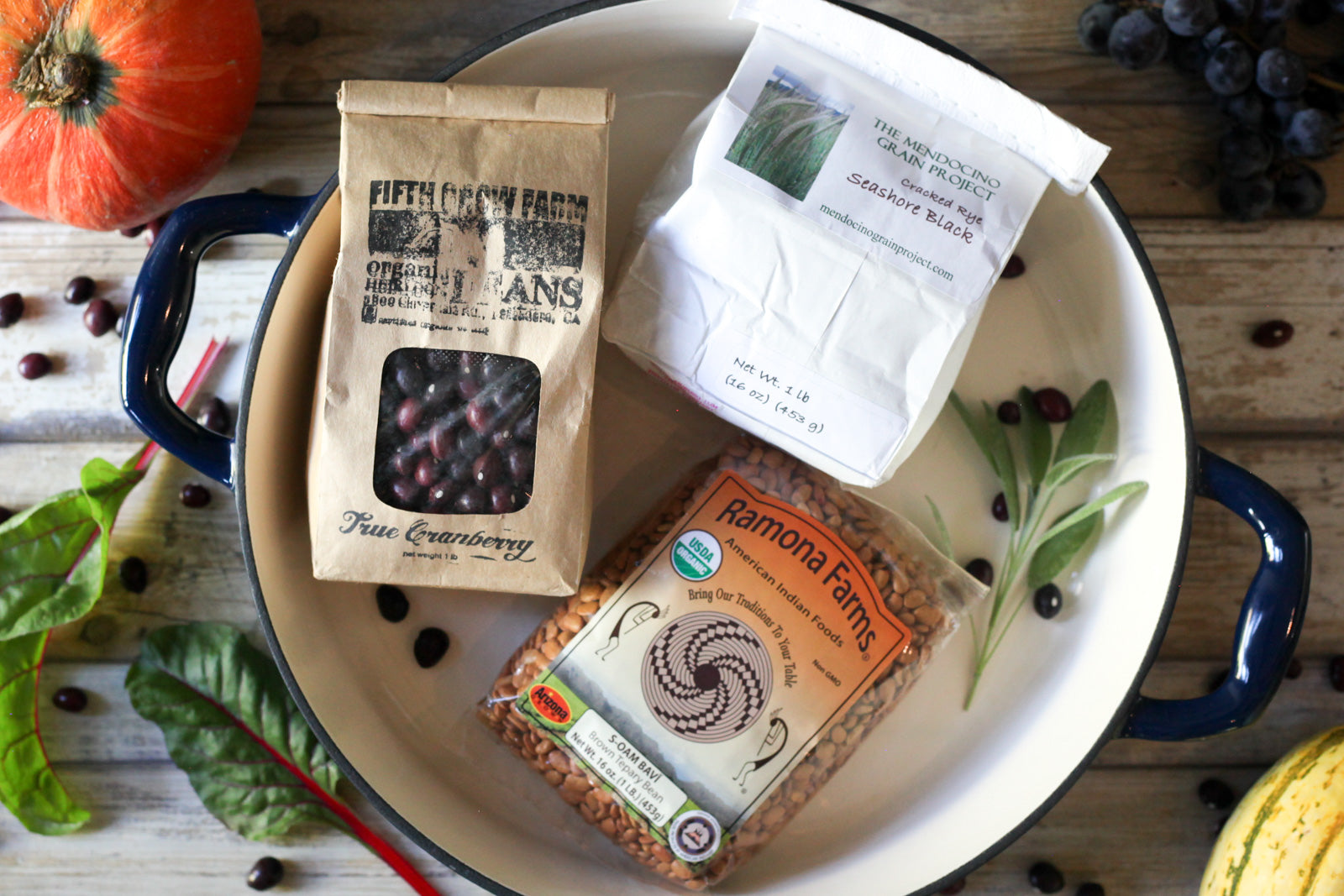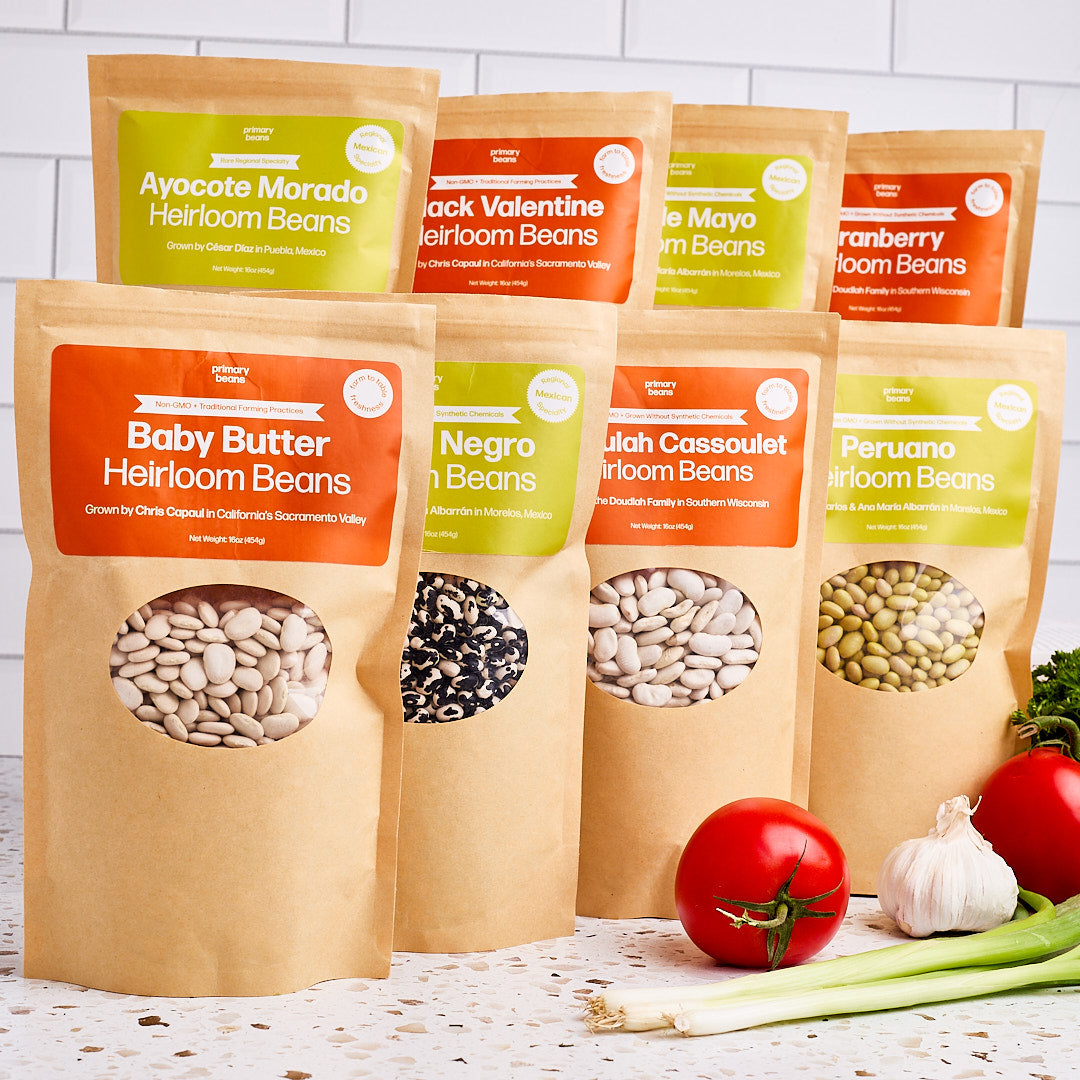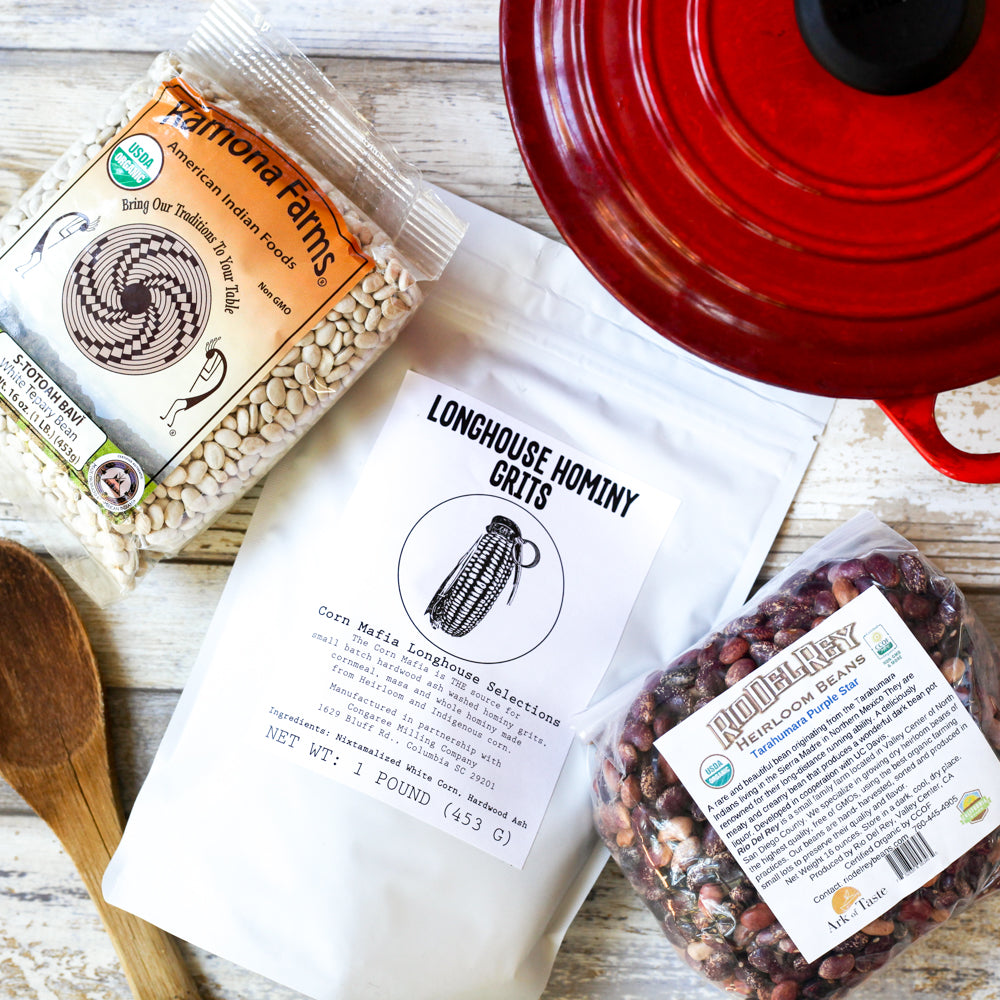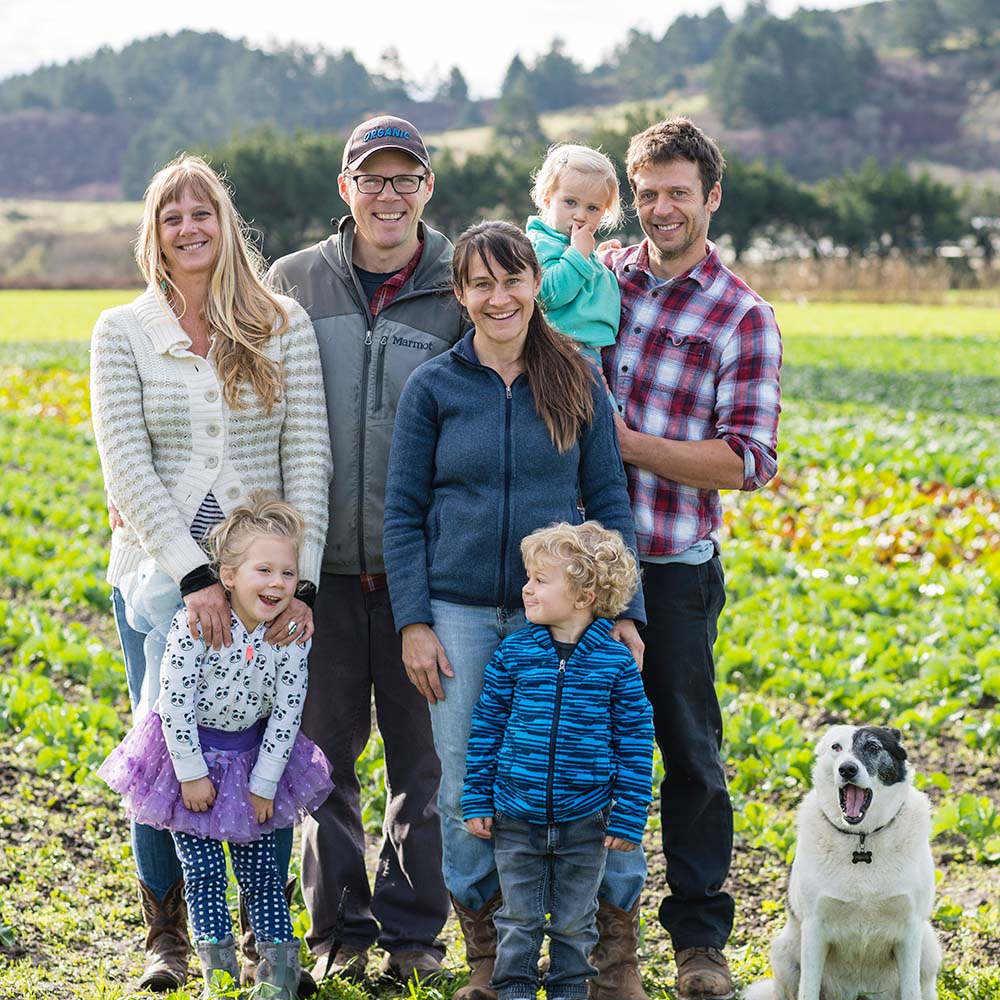10.99 FLAT RATE SHIPPING
10.99 FLAT RATE SHIPPING
SHOP

September Bean and Grain Club
September 01, 2022 8 min read
This month we partner with Slow Food USA to promote a little delectable history with beans and grains from the Slow Food Ark of Taste. The Ark of Taste is a living catalog of delicious and distinctive foods facing extinction. By identifying and championing these foods, we keep them in production and on our plates.

THE FAMILY BOX CONTAINS:
Organic True Red Cranberry Beans, Organic Brown Tepary Beans, Steel Cut Seashore Black Rye, Organic Old Indian Woman Beans, Kashmir Thin Skin Beans)
REGULAR SIZE CONTAINS:
Organic True Red Cranberry Beans, Organic Brown Tepary Beans, Steel Cut Seashore Black Rye
BEAN ONLY CONTAINS:
Organic True Red Cranberry Beans, Organic Brown Tepary Beans, Organic Old Indian Woman Beans
*The gluten free substitution is Rainbow Quinoa
TRUE RED CRANBERRY
This stunning blood red bean is recognized in the Slow Food Ark of Taste and indeed resembles its namesake. One of America's oldest and most unique varieties, The Red Cranberry bean was rediscovered by bean collector John Withee after an 11-year quest in Steep Falls Maine. This rare heirloom had been used by Abnaki Indians centuries ago but became extinct shortly thereafter due its tall stature that made it difficult for harvesting when grown at lowlands or gradual slopes. This plumps up to be marble sized jewels with a dense yet creamy texture and a rich, earthy flavor.
WHAT TO DO WITH IT
We think there could be no better bean to use in Sean Sherman's Cedar Braised Beans than the True Red Cranberry. We're also working on a recipe for a Pumpkin and True Red Cranberry Tamale so keep your eyes open for that.

ABOUT THE FARMER
Fifth Crow Farms is an organic family owned farm in Pescadero, California. Grounded in a values-based approach to land stewardship, Fifth Crow Farm is a dynamic and diversified organic farm in Pescadero, CA. Founded in 2008 with a shoestring budget, a supportive local community, and ambitious dreams, they strive to bring eaters the highest quality, best tasting, and most nutritious food possible.
Fifth Crow Farm wants their farm to be more than a business: they strive to make it an engine for positive change in the food system. They are stewarding the land in a way that not only respects but improves habitat for wildlife and builds better soil for future farmers. They also believe in creating a healthy, fulfilling, and fair work environment, and providing their customers with the best tasting, most nutritious, highest quality food possible.
ORGANIC TEPARY BEANS
The tepary bean, also an Ark of Taste ingredient, has been handed down for countless generations amongst the Akimel O’Odham (River People, Pima) people and the Tohono O’Odham (Desert People). It is native to the Sonoran Desert and has been cultivated by the indigenous people of the region for 4,000 years.The bavi or tepary bean, is the most drought adapted species of bean in the world.
Tepary beans are culturally very important to indigenous people of Southern and Central Arizona. It is said that the Tohono O’Odham, once referred to as Papago, were named after Papavi Kuadam which means ‘tepary eaters’. The tepary bean was once a large part of the indigenous diet in the Sonoran Desert, farmed in abundance along the Gila river. The reservation system caused a loss of traditional farming traditions and in the later 1800s the river was dammed and diverted with devastating effects. By the 1950s the tepary had all but disappeared. Due to the efforts of Ramona Farms the Akimel O'Odham people once again grow the tepary bean on their tribal land.
There are many colors of Tepary Bean however the brown is the most traditional. The family box contains both brown and the more rare gold tepary beans. The brown is grown on the O'Odham tribal land by Ramona Farms, the gold is grown in San Diego County by Rio Del Rey Farms. Both are grown organically using traditional farm methods. We encourage you to cook a small portion of each with just salted water to compare.
THE THREE SISTERS
The three sisters play a very important roll in Native American culture and foodways. Corn, beans and squash have been planted together and cooked together since ancient times. The beans are planted at the base of the corn, providing a natural trellis, the squash is planted around the corn and beans and the spiny leaves provide protection against predators. The beans in turn give nitrogen back to the soil for her sisters.
After being forced from their homes and relocated to the reservation system in the 1800s, many of these customs were lost. As they began the hard journey, the Native Americans sewed seeds into their clothes and hid them in their belongings, but reservations most often lacked water and resources for farming. Over time the knowledge of these traditions and many others were lost. The diet of the native people suffered as they lost this connection, causing an epidemic of obesity and diabetes. Thankfully many Native people are rediscovering their traditional foodways. There is a cultural resurgence that provides hope for us all. By learning from this ancient wisdom regenerative farming is creating more nutrient dense food that is also giving back to the earth.
Almost every Native American Nation seems to have its own myths and legends surrounding the three sisters. In each story they are central to our spiritual connection to the earth. My favorite is the legend of the 3 sisters who lived in a field together and loved each other. The eldest was tall and thin with golden hair and a green shawl, the middle sister wandered around the fields, the youngest could only crawl and needed to hold onto someone to stand up. One day in late summer a boy came to the field and they were fascinated with him, that night the youngest disappeared. A few weeks later he returned and this time the middle sister disappeared. The oldest sister was very sad and missed her sisters very much. At harvest time the boy returned and heard her crying so he took her to his home where she was united with her sisters. The sisters had decided to stay with the boy and his family because it was warm in their hut and they had a big pot of soup they were making. The sisters loved the family and dried themselves on a shelf so that they could help feed the family. From that day on, the family was never hungry and the sisters were never separated.
THREE SISTERS SOUP
- 2 tablespoons olive oil
- 1 cup of chopped onion
- 1 cup of brown or gold tepary beans
- 5 cups of veggie, chicken or turkey stock (if making this after Thanksgiving it is a wonderful way to use home made turkey stock)
- 2 cups of fresh or frozen corn
- 1/2 cup of mesquite dried pima corn soaked overnight (optional)
- 1 bunch of fresh sage leaves
- 1 teaspoon dried oregano
- 1/2 teaspoon dried cumin
- 1-2 dried peppers
- 2 cups of diced squash (We used a combination of yellow and green but acorn squash is lovely in this as well)
- 1 teaspoon finely chopped fresh sage
- Salt and Pepper
- (optional) chunks of left over turkey meat
Coat the bottom of a large pot or your instant pot with olive oil and saute the onion until soft but not brown. Add the beans, dried corn, stock, herbs and dried peppers. Bring to a boil and then reduce to a simmer, cover and cook for 1 hour. Add the fresh corn, squash and chopped fresh sage and simmer for another hour until the beans are fully cooked and the flavors have melded. (You could also add everything to a pressure cooker and cook for 45 minutes or in a slow cooker 4-6 hours). remove the sage leaves and dried pepper, season with salt and pepper and serve.
STEEL CUT SEASHORE BLACK RYE
Under many names, this hardy variety has been part of American farmland since 1831 when the Charleston City Gazette first advertised Carolina Seed Rye for sale in its pages. Sadly if feel out of favor and is only grown by a handful of farms today. Nutty and delicious, the grain has earned a place in the Slow Food Ark of Taste. Drought tolerant and heat resistant it was planted by the Mendocino Grain Project in Northern California who has specially milled it just for Foodocracy as a cracked whole grain which will make a delicious addition to all of your fall cooking. We love the color and the rich nutty flavor. This makes excellent veggie burgers, savory sides and delicious warm porridge for chilly fall mornings. When combined with savory seasonings it becomes a vegan meat substitute in our stuffed pumpkin recipe coming soon.

SEASHORE BLACK RYE AND ROASTED GRAPE PORRIDGE
Cook 1 cup of cracked rye on the stovetop with 3 cups of salted water until the water is absorbed (about 5-7 minutes). While that's cooking, roast some fall harvest grapes (we are loving the Thomcord in the farmers market right now), with a sprinkle of cinnamon and a light drizzle of sorghum or molasses in a 400 degree oven. Alongside the grapes roast a handful of your favorite nuts on a dry sheet pan. The grapes are done with they burst.
ABOUT THE FARMER
In the midst of the pandemic young farmer Rachel Britten took over the Mendocino Grain Project from the retiring founder. The Grain Project began in 2009 in an effort to provide their community with healthy grains and local food security. Rachel grows and mills grains like East Shore Black Rye in Mendocino County, California and because they have the capacity to clean and process grain for other farmers the ultimate goal is to provide what is necessary so that other local farmers can join the effort to grow more staple crops in Mendocino County.
ORGANIC OLD INDIAN WOMAN BEANS
We're so excited to have Old Indian Woman, also known as Yellow Indian Woman beans back. Years ago we had some from Rancho Gordo but they were not organic so this is an even more special treat. These are some of the most silky, delicious beans you'll find. The flavor is devine but it's that texture that brings everyone back.
WHAT TO DO WITH IT
We think there could be no better bean to use in Sean Sherman's Cedar Braised Beans than the True Red Cranberry. We're also working on a recipe for a Pumpkin and True Red Cranberry Tamale so keep your eyes open for that.
ORGANIC KASHMIR THIN SKIN BEANS
The Kashmir region of India is famous for its beauty and its cuisine. One of the Kashmiri specialties is the Kashmir thin skin bean, also known as the Kashmiri rajma. This small, dark red bean is prized for its delicate flavor and for its ability to retain its shape when cooked. Kashmiri cooks often use the Kashmir thin skin bean in dishes such as curries and stews, and it is also sometimes used in desserts. The Kashmir thin skin bean is a relatively rare variety of bean, and it is not widely available outside of Kashmir. However, we were lucky enough to get a small amount grown 100% organically by Mike Reeske and his family at Rio Del Rey Farm.
WHAT TO DO WITH IT
Making traditional Kashmiri Rajma seems like a great place to start. This popular dish can be found as a street food in India but is also made in every household as part of celebrations and special evenings with friends. The beans are cooked until they are soft and then simmered in a Kashmiri spice mixture, which typically includes fennel, cardamom, cloves, and ginger. Kashmiri rajma is usually served with rice or roti, and it can also be enjoyed with yogurt or chutney.

ABOUT THE FARMER
If you've never heard of Rio Del Rey Farms and Mikes beautiful 100% organic heirloom beans, it's probably because they aren't sold in stores and they're really hard to get your hands on.
Mike is a lifelong champion of sustainability with a sophisticated palette. After cooking up a batch of Rio Zape he turned his full attention to preserving rare heirloom beans a decade ago. He has been tasting, testing, growing beans ever since.
Recent Articles
About Us
Foodocracy is dedicated to creating a more sustainable and independent food system. We support small, independent farms across the nation.
Get impossible to find beans and grains shipped direct to your doorstep each month from small family farms.
We support small, family owned farms across the nation. Did you know that farmers only make an average of 10 cents on every dollar you spend at the supermarket? Working directly with farms and not middle men ensures that more money goes back to the people actually growning your food.
Get 10% Off
Sign up for delicious recipes and special offers.
**Regularly priced items only.



